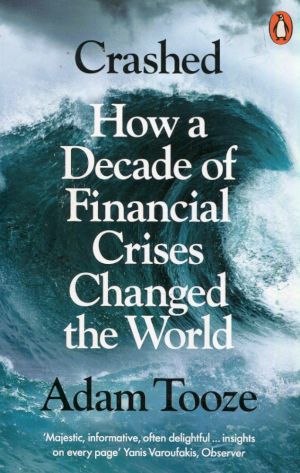25 July 2019
Crashed: how a Decade of Financial Crisis changed the World
Adam Tooze
2008, Allen Lane, 720 pages,
ISBN 9780141032214
Reviewer: Ian Harwood

It is difficult to exaggerate the severity of the shock imparted to the world’s collective psyche by the eruption of the global financial crisis. For a while it looked as if the resulting contraction of global activity, trade and employment would even exceed the collapses suffered during the Great Depression. Though a super-aggressive “shock and awe” policy response arrested the meltdown and laid the basis for the global economy resuming its expansionary trajectory, the world would never be quite the same again.
Indeed, now – a decade after the nadir of activity and equity markets, and with the critical metrics of world GDP, trade and employment having far surpassed pre-crisis highs – a sense of precariousness persists. The intervening period has hardly been smooth, even after the foundations for the US economy’s sustained upswing were laid. The Euro area threatened to implode until Draghi’s “whatever it takes” utterance, while China’s macro-stability has been periodically challenged, notably in 2015/16. Extraordinary policy measures have been taken, of a nature and magnitude previously unimaginable. The global financial crisis casts a long shadow and an innate pessimism obtains.
The challenges posed by the events themselves and their lengthy aftermath have been exhaustively analysed. Bookshelves groan under the weight of hefty tomes. Some seek to apportion blame. Others comprise the (largely self-exculpatory) memoirs of policy-makers. Yet more tender (if generally apocalyptic) predictions of what might lurk around the corner, these prognoses invariably including some combination of dollar collapse, hyper-inflation, Chinese economic disintegration and renewed global economic and financial meltdown. Few, however, have offered a genuinely well-balanced assessment of the global financial crisis and its implications. Barry Eichengreen, author of the magisterial “Hall of Mirrors” (2015), was arguably the most notable contributor. Gratifyingly, he has been joined on his plinth by Adam Tooze, author of the recently-published “Crashed”.
Tooze has excellent form as an historian, having written the award-winning “Wages of Destruction” (2006) and “The Deluge” (2014). Both these books can justly be described as path-breaking, as can his most recent contribution to the genre which is truly panoptic.
“Crashed” is a lengthy book, weighing in at more than six hundred pages. Given the extraordinary comprehensiveness of the coverage – it has a truly global focus – this is understandable. Nonetheless, nobody should be deterred by the length: it is intensely readable without any sacrifice being made to analytical rigour. ‘Crashed’ ranges widely and authoritatively over the terrains of politics and economics thereby constituting a triumph of Political Economy in the old-fashioned sense.
Tooze divides his narrative into four parts. The first, ‘The Gathering Storm’ (hat-tip to the first volume of Winston Churchill’s “History of the Second World War”), focuses upon the prelude to the crisis and the zeitgeist of heady optimism which prevailed. Inevitably, he focuses upon the brewing US sub-prime crisis but he also explains how European banking became so fatally intertwined with developments on the other side of the Atlantic. Refreshingly, he demonstrates how conventional wisdom fretted about the supposed vulnerability of the US dollar, a common historic obsession, rather than the severe domestic financial imbalances that were inexorably intensifying.
The second section focuses upon the global financial crisis per se; the third upon the subsequent travails of the Eurozone; the final upon “Aftershocks”, notably the rise of so-called populism in its various manifestations.
There is no easy way to conclude an evolving story of the dynamic interaction of international politics, economics and finance. While Tooze’s final chapter is entitled “The Shape of Things to Come”( another hat-tip: this time to HG Wells), he largely resists the temptation of crystal ball-gazing. To the avid reader, this is a disappointment, but perhaps he is too wise to leave hostages to fortune. Historians, after all, are trained to rationalise the past.
I would unhesitatingly recommend this book. Any investor would benefit from such a panoramic diagnosis of the past decade – particularly those too young to have experienced the global financial crisis first hand.
